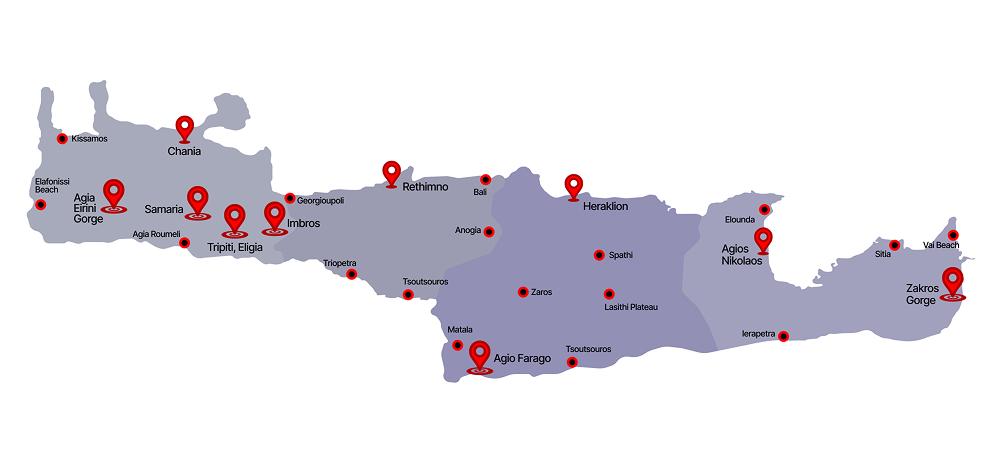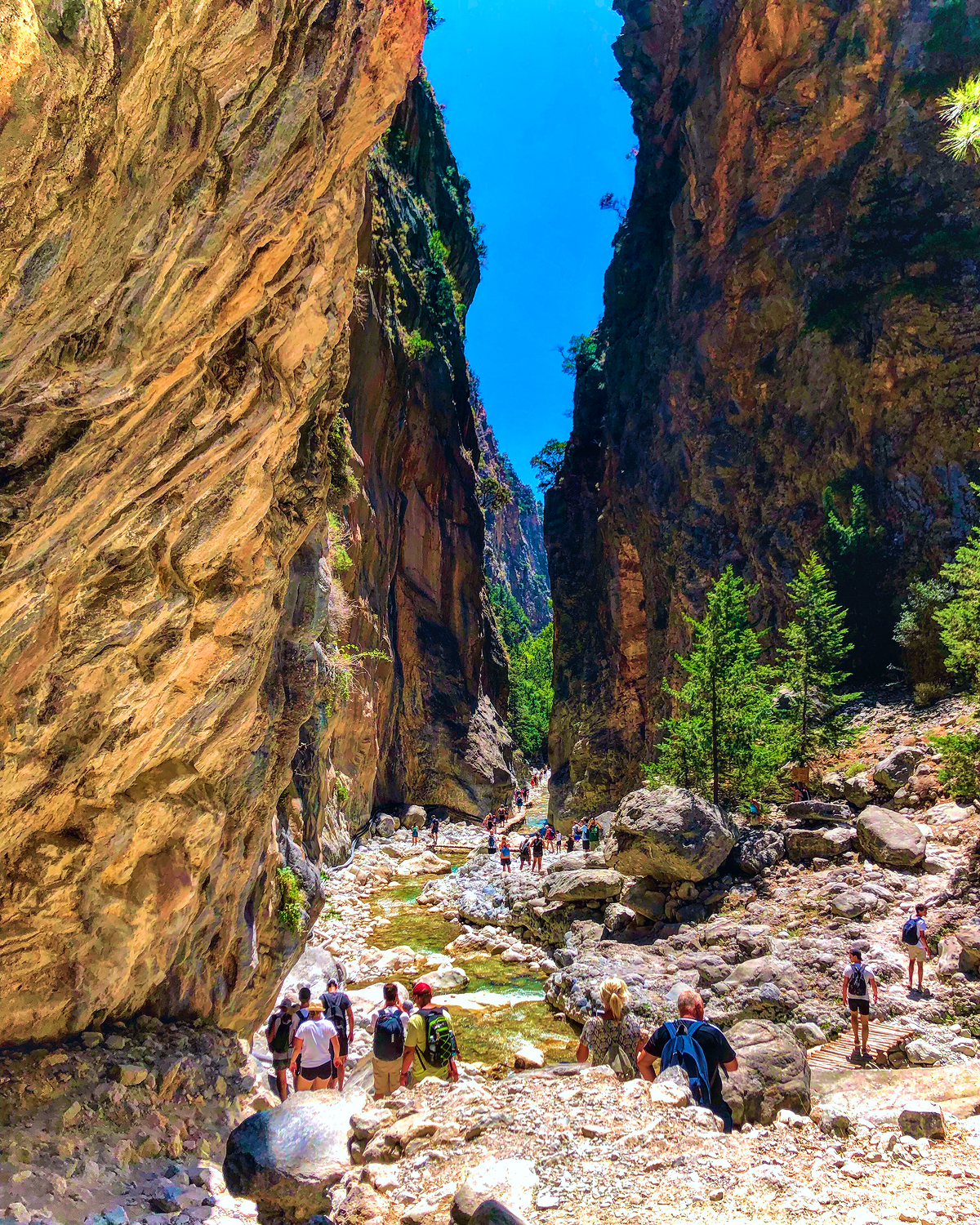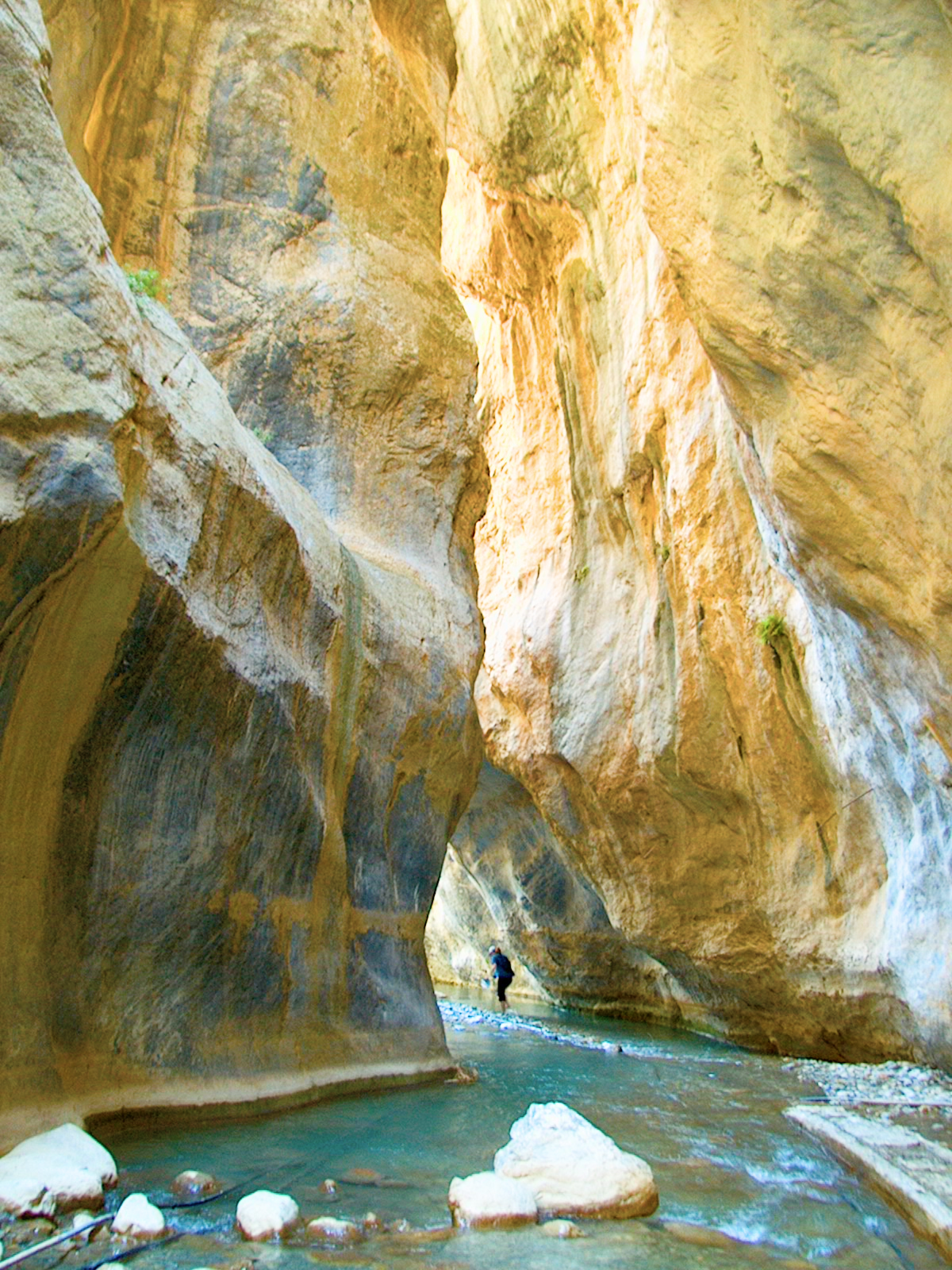Fabulous gorges of Crete
Walk through breathtaking landscapes, discover rare wildlife, and enjoy unforgettable hikes in Crete’s most famous gorges.

Mother Nature has been extremely benevolent to the unique island of Crete. Not only is the island endowed with a plethora of beaches: some sandy, some rocky, some obvious and many hidden, the island is also home to many natural geographical features. There are too many to name them all, but here are the most popular.
Samaria Gorge
Undoubtedly one of the most visited tourist attractions on the island. It is not for the fainthearted and requires stamina and some physical strength in order to walk the rocky terrain which is 16km in distance. Located in the White Mountains of Hania the gorge begins at Omalos at an altitude of 1200m. In 1962 it became a National Park of Greece and it is well-known for its flora and fauna. Indeed there are many wild herbs and rare plants and of course the famous Cretan mountain goat, the Kri Kri is to be found scalling the mountain tops and the sides of the gorge.

The gorge at its widest has a width of 150 m and at its most narrow only 3m. Descending the gorge will bring you out at the south end of Crete, and a further 3 km down at Agia Roumeli and a view of the Libyan Sea. En route there are many water fountains and toilets available for hikers. The beach at Agia Roumeli offers a rejuvenating dip in the water and there are a few restaurants offering refreshment. The hike through the Gorge can take anything from 4 to 8 hours depending on your physical abilities and how long you stop for breaks. Be warned at the end that a boat trip is required to take you to Sfakia (takes 30 minutes) and then to make your way back via the roads. It is not an easy day out and needs to be well-planned in advance. With your car rental, we can suggest additional places worth visiting, and you also have the option to include GPS in your vehicle for extra convenience.
Gorge of Imbros
This is probably the second most popular gorge for walkers in Crete (the first being of course the highly organised gorge of Samaria). Its popularity can be put down to its much easier terrain. The average walking time is about 2.5 hours to cover its 8 km in length. Also the path underfoot is less harsh and the gorge is even suitable for children.
The gorge is easy to access via a decent road towards Hora Sfakion and south Crete which runs the upper length of the gorge. Also, you don't need a ferryboat ride to get back!
Although it is considerably smaller than most gorges this should not put you off. It offers spectactular sights and additionally it is open all year round. In places the gorge is particularly narrow and this only adds to its attractiveness.
The gorge is noted as being the route to escape for many allied troops during the Second World War when in May 1941 they journeyed through the gorge to escape to neighborouing Egypt. Visitors in particular from Australia and New Zealand consider the trip as almost a pilgrimage. In the surrounding area there are also many points of historical interest, which you can ask us to show you during your visit.

The gorge of Agia Irini in Hania
Situated near Selino in the west of the White Mountains 43 km from Hania. The gorge takes its name from the village of Agia Irini which is located in a valley along the winding road that leads from Hania to Sougia in southwest Crete and is close to the northern entrance.
The gorge is less crowded and has the advantage of being open all year round and with a length of 7.5 km it takes about a manageable 3 hours to walk. Its descent is only around 500 m and this makes for easier legwork. Most of the walk is shaded which makes it ideal even in the hotter months. The gorge offers shelter to many animal species such as the Cretan wild goat (Kri Kri) and various species of trees, plants and herbs can be seen. If you enjoy excursions, we can guide you to nearby beaches, waterfalls and other remarkable attractions worth discovering. The village of Sougia with its beauftil beach overlooking the Libyan sea is only 5 km from the southern entrance of the gorge.
Agio Farago - Holy Gorge
This special gorge is located in south Crete, near Matala and Kali Limenes. From Heraklion it is only 80 km. The gorge takes about 30 to 50 minutes to walk (depending on your stamina) and exits out into a secluded beach only accessible from the Gorge. (unless you have a boat of course).
At the beginning of the gorge you will notice the church of Agia Kyriaki which is set in a cave. The gorge is a natural monument with more large caves on either side. In days long gone, these were home to hermits who lived a life of prayer and solitude. Also you will see the chapel of St Anthony which has a well outside. The beach is one of the finest in southern crete and is a welcome site after the gorge.
There are ferries which can take you there but then you would miss the adventure of walking the gorge. If you fancy a spot of rock climbing then a vertical climb is available and from the top the views are amazing. Looking out over the Libyan Sea!
If you plan to go be well-prepared. Take water and provisions with you.
Gorges Klados, Tripiti and Eligia
In the immediate vacinity of Sarmaria Gorge, south in the municipal of Hania there are a number of gorges all offering adventure, a challenge and are strictly suitable only for the experienced climber / hiker.
The first one to the west of Samaria is the Klados Gorge. The path leading to its entrance on the north starts from the Linosseli pass. It is suitable for the fully equipped climber as in parts the steep slope has a coverning of loose gravel and proper walking attire is a must. Not to mention a nine-hundred precipice just to add to the danger! If that isn't enough there are three points in the gorge which require descending by rope and before going you should check the weather forecast. After heavy rainfall and snow melts these drops are home to cascades of water. If you do manage to pass through the gorge you will find yourself at the same beach of its neighbouring gorge of Tripiti.

The next adjacent gorge of Tripiti is located near the village of Lentas. It got its name from the church of Panagia Tripiti which is built inside a cave of the gorge. It is relatively small in length and you can cross it even by car or motorbike. The scenery is truly magical and the tall cliffs rising in many parts of the gorge will take your breath away. After passing the gorge you will find yourself at the beautiful and secluded sandy beach of Tripiti. Here you can bathe in the refreshing clear waters and find some shade under the trees.
To return to civilisation there is a coastal path eastwards which will take you to Agia Roumeli (a quick five to six hour walk!!). The shores are very steep and the path climbs the mountain to as much as 700 m.
This will bring you to Agia Roumeli and from here you can take a boat to Chora Sfakion. East of Samaria gorge is the Eligia Gorge. Its north entrance starts from the Katsiveli refuge. This is a fairly walkable gorge but it is best to be well-prepared and have knowledge of the correct pathway. The gorge is extremely narrow and deep from one end to the other. It is characteristic for its steep descent and its lush vegetation. Again care is needed depending on the weather of the season. After periods of heavy rain the gorge is prone to becoming a waterway. To return again take the same coast path to Agio Roumeli, this time a relatively easy one-hour walk.
The gorge of the Dead / Gorge of Zakros
This is a small gorge in East Crete which starts shortly after the village of Ano Zakros and ends at the village and beach of Kato Zakros (Upper and Lower Zakros), 38 km south of Sitia, eastern Crete.
Don't be alarmed by its name. This dates back to the ancient Minoans who used the caves in its steep cliffs to bury their dead. What made them do this remains a mystery, but it must have been an honour in that ancient civilisation considering the risk to life simply by maneuvering the dead up the sheer inclines of the gorge in order to place them in their final resting place.
Having said that the gorge nowadays is still as breaktaking as then and is easily accessed. There is a second entrance 4 km from Ano Zakros and is a good shortcut. Also there is plenty of room for parking a vehicle at this point. If you do leave your car at this end of the gorge you could then return via bus back to the same parking area. Taking this route will take you a mere 2 hours walk to the exit which is just before the Minoan Palace of Zakros and the beach at Kato Zakos.
The gorge presents no difficulties during the summer months. The first steep slope may seem a bit daunting but in fact there’s no danger as long as you follow the path carefully. After a 15-minute descent you will find yourself at the bottom of the gorge and from here you can safely follow the riverbed which of course in summer is completely dry. In winter months and spring, particularly after heavy rainfall, the gorge presents a different story. The river will be full of water and you will need to jump from stone to stone to cross it several times. The terrain will be unstable and the rocks slippy underfoot. Caution is advised and the appropriate footwear a must.
Whichever season you visit this gorge you can be guaranteed of yet another impressive adventure full of imposing views of the wonderful Cretan landscape.




